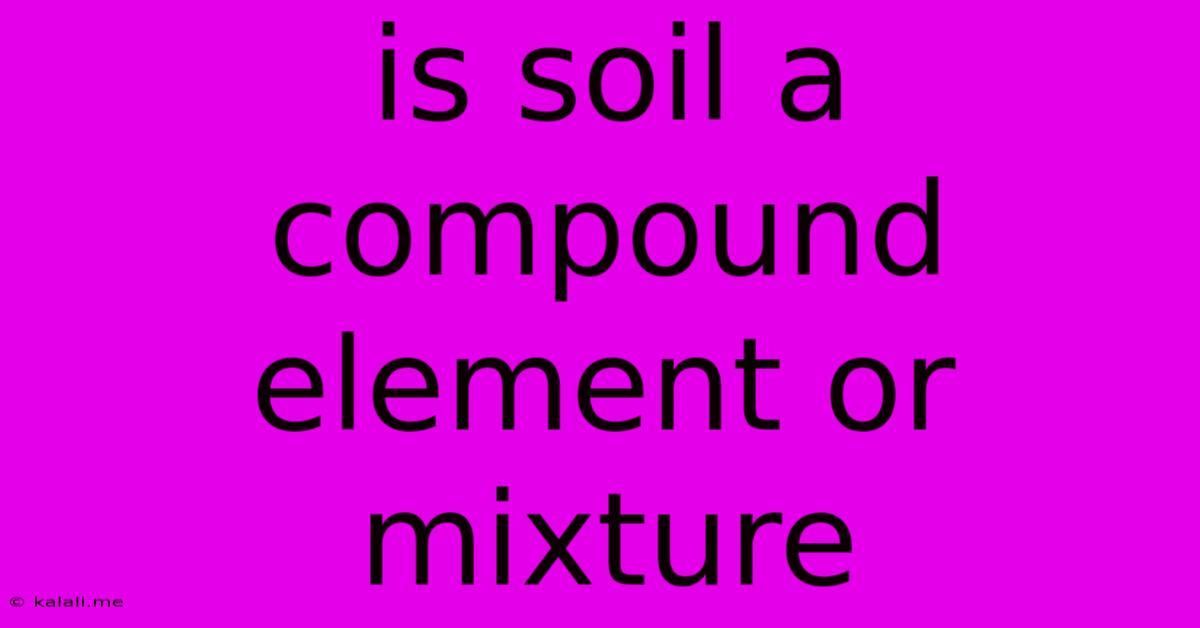Is Soil A Compound Element Or Mixture
Kalali
Jun 13, 2025 · 3 min read

Table of Contents
Is Soil a Compound, Element, or Mixture? Understanding Soil Composition
Soil, the foundation of terrestrial life, is far more complex than it initially appears. This article delves into the fundamental question: is soil a compound, an element, or a mixture? Understanding this will illuminate the intricate processes and components that make soil such a vital resource. We'll explore the different components of soil and explain why it's classified as a heterogeneous mixture.
Soil is a heterogeneous mixture, not a compound or an element. This means it's composed of various substances that aren't chemically bonded together in a fixed ratio. Instead, soil is a dynamic blend of organic and inorganic materials, each contributing to its unique properties.
What Makes Soil a Mixture?
Several key factors contribute to soil's classification as a mixture:
-
Varied Composition: Soil consists of a diverse range of components, including mineral particles (sand, silt, clay), organic matter (decomposed plants and animals), water, air, and living organisms (bacteria, fungi, insects, etc.). The proportions of these components vary significantly depending on location, climate, and parent material. This variability is a hallmark of mixtures.
-
Lack of Fixed Ratio: Unlike compounds, which have a defined chemical formula (e.g., H₂O for water), soil doesn't possess a consistent ratio of its constituents. The percentage of sand, clay, or organic matter can change dramatically from one soil sample to another.
-
Physical Separation of Components: The components of soil can be physically separated using various methods. For instance, sieving can separate soil particles based on size, while centrifugation can separate water and solid components. This physical separability is another indicator of a mixture.
Components of Soil: A Closer Look
Understanding the individual components of soil further clarifies why it's a mixture:
-
Mineral Particles: These inorganic particles are derived from the weathering of rocks and minerals. They are categorized by size into sand, silt, and clay, each impacting the soil's texture and drainage properties. This is a physical, not chemical, categorization.
-
Organic Matter: This is the decomposed remains of plants and animals, providing crucial nutrients and improving soil structure. Humus, a stable form of organic matter, contributes significantly to soil fertility.
-
Water: Soil water is essential for plant growth and acts as a solvent for nutrients. The amount of water in soil varies greatly depending on precipitation and drainage.
-
Air: The pore spaces in soil contain air, vital for the respiration of soil organisms. Air composition in soil can differ from atmospheric air.
-
Living Organisms: A vast array of organisms inhabit soil, playing vital roles in nutrient cycling and decomposition. Bacteria, fungi, earthworms, and insects all contribute to soil health and function.
Distinguishing Soil from Compounds and Elements
To further emphasize the distinction, let's briefly define compounds and elements:
-
Compound: A substance formed when two or more chemical elements are chemically bonded together. Compounds have a fixed ratio of their constituent elements. Examples include water (H₂O) and carbon dioxide (CO₂).
-
Element: A pure substance consisting only of atoms that all have the same number of protons in their atomic nuclei. Elements cannot be broken down into simpler substances by chemical means. Examples include oxygen (O) and iron (Fe).
Soil clearly doesn't fit either of these definitions. It lacks the chemical bonding characteristic of compounds and comprises many different elements and their compounds in varying proportions.
In conclusion, soil is a complex heterogeneous mixture of mineral particles, organic matter, water, air, and living organisms. Its varied composition, lack of a fixed ratio of components, and the ability to physically separate its constituents clearly distinguish it from compounds and elements. Understanding this fundamental aspect of soil is crucial for appreciating its intricate nature and its vital role in supporting life on Earth.
Latest Posts
Latest Posts
-
Difference Between A Magazine And A Newspaper
Jun 14, 2025
-
Good Words To Describe Your Mother
Jun 14, 2025
-
Operant Conditioning Is Also Known As
Jun 14, 2025
-
Columbia University New York Gpa Requirements
Jun 14, 2025
-
Bronze Is A Mixture Of What
Jun 14, 2025
Related Post
Thank you for visiting our website which covers about Is Soil A Compound Element Or Mixture . We hope the information provided has been useful to you. Feel free to contact us if you have any questions or need further assistance. See you next time and don't miss to bookmark.